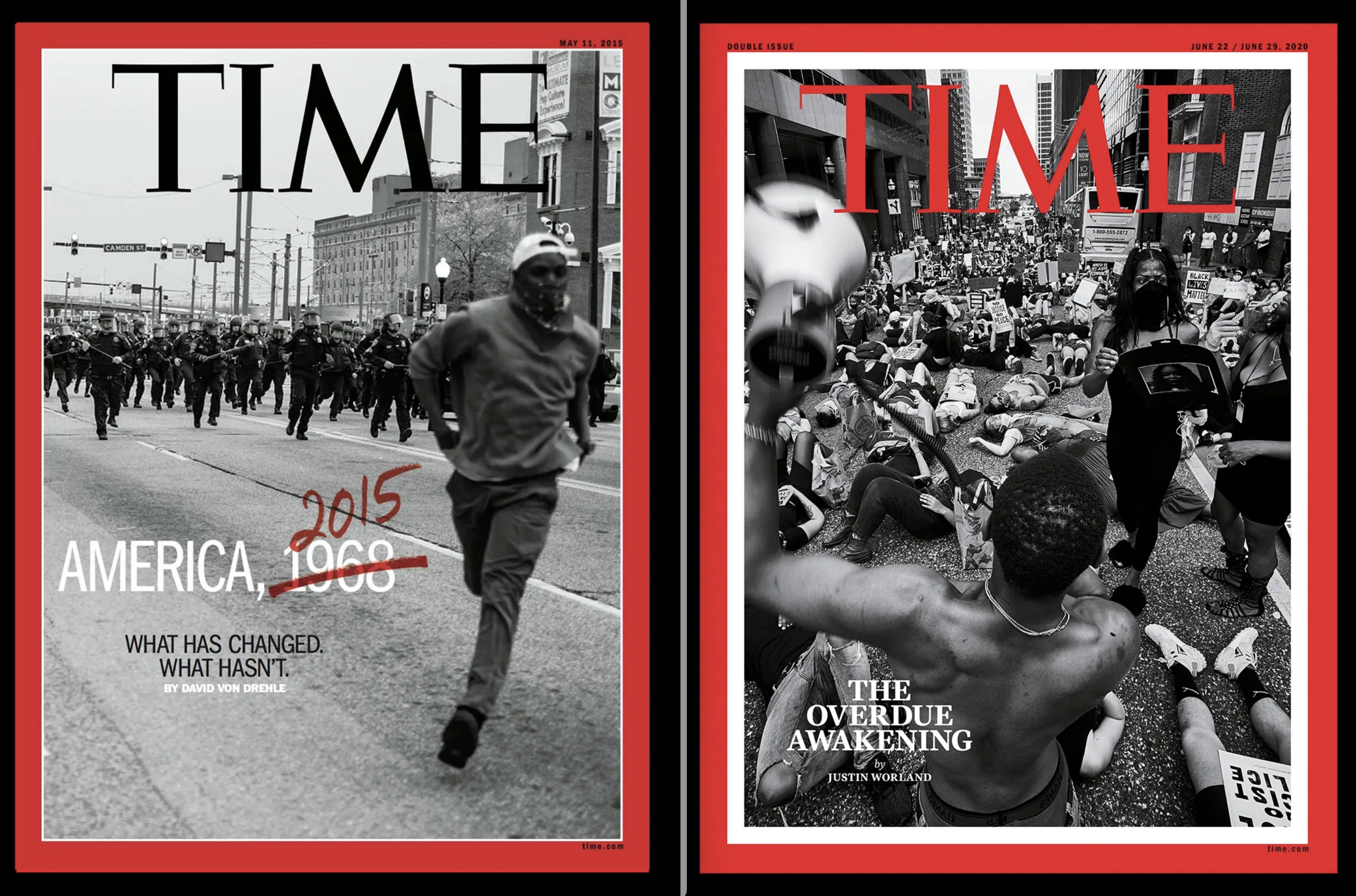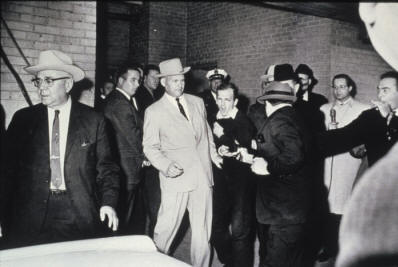Via Tennessee Trip Tales
You’ve seen Ernest C. Withers’ photographs whether or not you know his name. Last October, they
showed in Berlin and
draped a building façade in Washington, D.C. If you saw Katori Hall’s play,
The Mountaintop, his were the images that shook the final scene. Even before his death in 2007, Withers’ work had exhibited internationally and appeared in films (see 2004’s
The Manchurian Candidate with Denzel Washington).
But Withers’ daughter, Rosalind, says her father realized the significance of his work much earlier in his career – specifically, in 1955, when his images of Emmett Till – from the boy’s brutally beaten corpse to his murder trial and funeral – were released worldwide and credited with bringing so much attention to the U.S. civil rights movement.
In a self-published “photo story” following the acquittal of Till’s alleged murderers, Withers wrote: “…we are presenting this…not in an attempt to stir up racial animosities or to question the verdict…but in the hope that [it] might serve to help our nation dedicate itself to seeing that such incidents need not occur again.”
And so his career goes, with Withers assuming the charge of telling pivotal chapters of our country’s 20th-century civil rights story in pictures. Today, you can view the most iconic images in
The Withers Collection Museum & Gallery, located on the east end of the Beale Street entertainment district in a building that formerly housed Withers’ studio (and that was named for him in 1995).
The intimate space distills Withers’ vast collection into 10 major “projects.” The school desegregation section shows members of the Little Rock Nine exiting their car (in the background, white students crowd the entrance to their school in protest). A section devoted to Medgar Evers grips you in the faces of Evers’ family attending his funeral. In another section, titled “Memphis and The South,” signs say everything – in a poster held by a young, white man (“Segregation or war!”); in a placard worn by a father strolling his infant daughter (“Daddy, I want to be free too!!!!”). There are moments of triumph, too – when the Montgomery Bus Boycott set that city’s first desegregated bus rolling in 1956, Withers and his camera were there.
Even if you’ve seen these images in other contexts, you’ll immediately recall them – once seen, they never leave your consciousness. Viewed in aggregate, they seem to me even more powerful – as does Withers’ ability to capture the most critical moments at such close range. As for Withers’ near-omnipresence along the civil rights timeline, Rosalind explains simply that her father was a “journalist by nature.” She offers more on the intimacy her father achieved with his subjects, referencing several of his images of Dr. Martin Luther King, Jr. – particularly one of Dr. King lounging on his bed at the Lorraine Motel (King was in Memphis to join James Meredith’s 1966 March Against Fear). “It speaks to his character that he was able to get so close,” Rosalind believes.
It shouldn’t be lost on anyone that the gallery opens and closes on Dr. King – presenting first the images from 1966 of the man in repose; ordering lunch; looking cool marching in sunglasses and a hat. By the end of the exhibit, it’s two years later, and Withers’ lens is trained on Memphis’ sanitation worker strike (source of Withers’ most recognizable image, shown below) and Dr. King’s last march; King’s blood spilled on the balcony of the
Lorraine Motel; masses gathered in Memphis and Atlanta following the assassination – and the riots. It’s hard to imagine, under its present-day neon glow, a Beale Street strewn with tanks and evenly-spaced soldiers, propped with their rifles against shattered-and-boarded windows. But Withers’ images show it like it was.
Many of the images displayed at Memphis’ Withers Collection Museum & Gallery are the same ones you’ll see archived by the Library of Congress and incorporated into the permanent collection of Washington, D.C.’s in-progress
National Museum of African American History and Culture, a Smithsonian institution. Major purchases by both organizations helped to fund the creation of the Memphis museum and gallery, which opened in May 2011. Image courtesy of and copyrighted by the Withers Family Trust. All rights reserved. No images can be reproduced without permission.
The gallery takes two lighthearted turns, driven by Withers’ chronicling of baseball and music – and ultimately giving what I saw as the clearest insight into the photographer’s personal life: His series on the Negro Baseball League grew from the portraits players and fans would pay him to take at the ballpark. Withers had no studio at the time, so he would develop prints in the bathtub of his home and dry them in the family’s oven. “I still remember that smell in our house,” Rosalind laughs, but those prints helped Withers and wife Dorothy raise eight children. They were also what drew Dorothy into business with her husband. “He would print and my mom would count [the prints] and tell him how much money he would have to bring home,” Rosalind recalls.
The Withers Collection Museum & Gallery is located at 333 Beale Street in a building that housed Withers’ studio (and that was named for him in 1995). The now-vacant studio space still bears this window marking.
As for the music, Withers served as
Stax Records’ official photographer for two decades. “He loved the blues and B.B. King was one of his best friends,” Rosalind tells me, noting that he also liked listening to Al Green and Isaac Hayes, whose relationship with Withers was so close, the performer called him “Pops.” To caption Withers’ images of Memphis music history through the 1950s and ’60s is to name-drop star after star: Sam Cooke, Aretha Franklin, Elvis Presley, Tina Turner – though I especially enjoyed the juxtaposition of two of Withers’ images of B.B. King: one of a newbie playing in a club on Beale Street circa-1950; the other of a veteran playing in his own club on
Beale Street in 1994.
“’I am a man,’ and Elvis and B.B. – that’s Memphis,” Rosalind immediately offered when we began discussing which of her father’s images should accompany this piece. Image courtesy of and copyrighted by the Withers Family Trust. All rights reserved. No images can be reproduced without permission.
What’s next for Withers?
Among individual photographers covering the civil rights movement, Withers is commonly credited with producing the largest body of work. Though her father once told her his portfolio was five million images strong, Rosalind has stopped counting (for now, at least) at one million. Of those, only a few thousand have been digitized.
The images sit – some as negatives; others as prints – in a pandemonium of file cabinets, cardboard boxes and card catalog-style units in a space near the gallery. There is some clarity in the chaos courtesy of the Withers’ original subject-matter categorization, but the takeaway is this: The images need to be legitimately archived. Rosalind has a plan for that, but not the money. During our interview, she was preparing for a black tie fundraiser to that end. She also previewed
memberships the museum will soon be offering to help offset the costs of archival, and expansion. (An ambitious project will be announced this spring to expand the gallery’s current 7,000 square feet to 28,000 – including an amphitheater for musicians and theater groups and a restaurant.)
Until then, Withers’ images will receive their largest showing since his death (in 2007) during the April 3-7 gathering of the Association of International Photography Art Dealers at New York City’s Park Avenue Armory. (Monroe Gallery of Photography, Booth #419)
You only have to go as far as Beale Street.
While Rosalind and her team work to raise the funds necessary to properly archive her father’s body of work, the images remain in Withers’ original filing system (offsite). “All of this handwriting is my mother’s and father’s,” Rosalind reflected.
Before you go:The Withers Collection Museum & Gallery (333 Beale Street) is open Wednesdays and Thursdays, 4-10 p.m.; Fridays and Saturdays, 4-11 p.m. and Sundays, 4-9 p.m. (Daytime tours are available for groups of 10 or more by reservation.)
With a short video on the photographer’s life and more than 90 images on display, plan to spend around an hour.
Currently, admission is a suggested donation of $5-10. Beginning March 1, 2013, admission will be $10 for adults and $7 for children with
membership packages at various levels.
Note that some of the gallery images are sensitive in nature (read: prepare your children in advance – and be prepared to answer their questions during and after viewing the exhibit).









